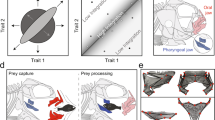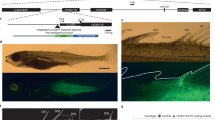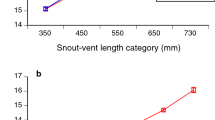Genes and environment stretch snake jaws to meet the demands of prey size.
Abstract
The morphology of organisms is generally well matched to their environment, presumably because expression of their genes is tailored either at the population or the individual level to suit local conditions: for example, snake populations that persistently encounter large prey may accumulate gene mutations that specify a large head size, or head growth may be increased in individual snakes to meet local demands (adaptive developmental plasticity)1. Here we test the relative contributions of genetics and environment to the jaw sizes of two tiger snake populations: one that consumes small prey on the mainland, and an island population that relies on larger prey and has a larger jaw size. Although the idea of adaptive plasticity in response to environmental pressures is controversial2, we find that both factors influence the difference in jaw size between the two populations, and the influence of developmental plasticity is greater in the island population.
This is a preview of subscription content, access via your institution
Access options
Subscribe to this journal
Receive 51 print issues and online access
$199.00 per year
only $3.90 per issue
Buy this article
- Purchase on Springer Link
- Instant access to full article PDF
Prices may be subject to local taxes which are calculated during checkout


Similar content being viewed by others
References
Bock, W. J. Am. Zool. 20, 217–227 (1980).
Dudley, S. A. & Schmitt, J. Am. Nat. 147, 445–465 (1996).
Forsman, A. & Shine, R. Biol. J. Linn. Soc. 62, 209–223 (1997).
Cogger, H. G. Reptiles and Amphibians of Australia (Reed, Chatswood, Australia, 1992).
Shine, R. Herpetologica 43, 233–240 (1987).
Aubret, F., Maumelat, S., Bonnet, X., Bradshaw, D. & Schwaner, T. Amphibia–Reptilia 25, 9–17 (2003).
Pigliucci, M. Phenotypic Plasticity: Beyond Nature and Nurture (Johns Hopkins University Press, Baltimore, 2001).
Author information
Authors and Affiliations
Corresponding author
Ethics declarations
Competing interests
The authors declare no competing financial interests.
Rights and permissions
About this article
Cite this article
Aubret, F., Shine, R. & Bonnet, X. Adaptive developmental plasticity in snakes. Nature 431, 261–262 (2004). https://doi.org/10.1038/431261a
Published:
Issue Date:
DOI: https://doi.org/10.1038/431261a
This article is cited by
-
Island Tiger Snakes (Notechis scutatus) Gain a ‘Head Start’ in Life: How Both Phenotypic Plasticity and Evolution Underlie Skull Shape Differences
Evolutionary Biology (2023)
-
Ontogenetic shift in diet of a large elapid snake is facilitated by allometric change in skull morphology
Evolutionary Ecology (2022)
-
Island colonisation and the evolutionary rates of body size in insular neonate snakes
Heredity (2015)
-
Resource partitioning and dwarfism patterns between sympatric snakes in a micro‐insular Mediterranean environment
Ecological Research (2015)
-
A multi-organ transcriptome resource for the Burmese Python (Python molurus bivittatus)
BMC Research Notes (2011)
Comments
By submitting a comment you agree to abide by our Terms and Community Guidelines. If you find something abusive or that does not comply with our terms or guidelines please flag it as inappropriate.



